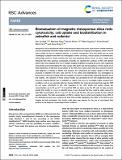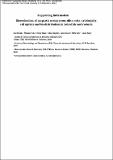Por favor, use este identificador para citar o enlazar a este item:
http://hdl.handle.net/10261/283924COMPARTIR / EXPORTAR:
 SHARE SHARE
 CORE
BASE CORE
BASE
|
|
| Visualizar otros formatos: MARC | Dublin Core | RDF | ORE | MODS | METS | DIDL | DATACITE | |

| Título: | Bioevaluation of magnetic mesoporous silica rods: cytotoxicity, cell uptake and biodistribution in zebrafish and rodents |
Autor: | Grzelak, Jan Jacek; Teles, Mariana; Roher, Nerea; Grayston, Alba; Rosell, Anna; Gich, Martí CSIC ORCID; Roig Serra, Anna CSIC ORCID | Palabras clave: | Fatty liver-desease Drug-delivery Nanoparticles Endocytosis |
Fecha de publicación: | 7-nov-2022 | Editor: | Royal Society of Chemistry (UK) | Citación: | RSC Advances 12(49): 31878-31888 (2022) | Resumen: | Mesoporous silica nanoparticles (MSN) characterized by large surface area, pore volume, tunable chemistry, and biocompatibility have been widely studied in nanomedicine as imaging and therapeutic carriers. Most of these studies focused on spherical particles. In contrast, mesoporous silica rods (MSR) that are more challenging to prepare have been less investigated in terms of toxicity, cellular uptake, or biodistribution. Interestingly, previous studies showed that silica rods penetrate fibrous tissues or mucus layers more efficiently than their spherical counterparts. Recently, we reported the synthesis of MSR with distinct aspect ratios and validated their use in multiple imaging modalities by loading the pores with maghemite nanocrystals and functionalizing the silica surface with green and red fluorophores. Herein, based on an initial hypothesis of high liver accumulation of the MSR and a future vision that they could be used for early diagnosis or therapy in fibrotic liver diseases; the cytotoxicity and cellular uptake of MSR were assessed in zebrafish liver (ZFL) cells and the in vivo safety and biodistribution was investigated via fluorescence molecular imaging (FMI) and magnetic resonance imaging (MRI) employing zebrafish larvae and rodents. The selection of these animal models was prompted by the well-established fatty diet protocols inducing fibrotic liver in zebrafish or rodents that serve to investigate highly prevalent liver conditions such as non-alcoholic fatty liver disease (NAFLD). Our study demonstrated that magnetic MSR do not cause cytotoxicity in ZFL cells regardless of the rods' length and surface charge (for concentrations up to 50 μg ml-1, 6 h) and that MSR are taken up by the ZFL cells in large amounts despite their length of ∼1 μm. In zebrafish larvae, it was observed that they could be safely exposed to high MSR concentrations (up to 1 mg ml-1 for 96 h) and that the rods pass through the liver without causing toxicity. The high accumulation of MSR in rodents' livers at short post-injection times (20% of the administered dose) was confirmed by both FMI and MRI, highlighting the utility of the MSR for liver imaging by both techniques. Our results could open new avenues for the use of rod-shaped silica particles in the diagnosis of pathological liver conditions. | Versión del editor: | http://dx.doi.org/10.1039/d2ra05750f | URI: | http://hdl.handle.net/10261/283924 | DOI: | 10.1039/d2ra05750f | E-ISSN: | 2046-2069 |
| Aparece en las colecciones: | (ICMAB) Artículos |
Ficheros en este ítem:
| Fichero | Descripción | Tamaño | Formato | |
|---|---|---|---|---|
| Grzelak_RSCAdv_2022_editorial.pdf | Artículo principal | 979,12 kB | Adobe PDF |  Visualizar/Abrir |
| Grzelak_RSCAdv_2022_suppl_editorial.pdf | Información complementaria | 995,52 kB | Adobe PDF |  Visualizar/Abrir |
CORE Recommender
PubMed Central
Citations
1
checked on 29-abr-2024
SCOPUSTM
Citations
1
checked on 04-may-2024
WEB OF SCIENCETM
Citations
1
checked on 25-feb-2024
Page view(s)
26
checked on 07-may-2024
Download(s)
19
checked on 07-may-2024

